Sky & Telescope predicts that the year’s best meteor shower will be the dependably strong, fireball-rich Perseids in mid-August.
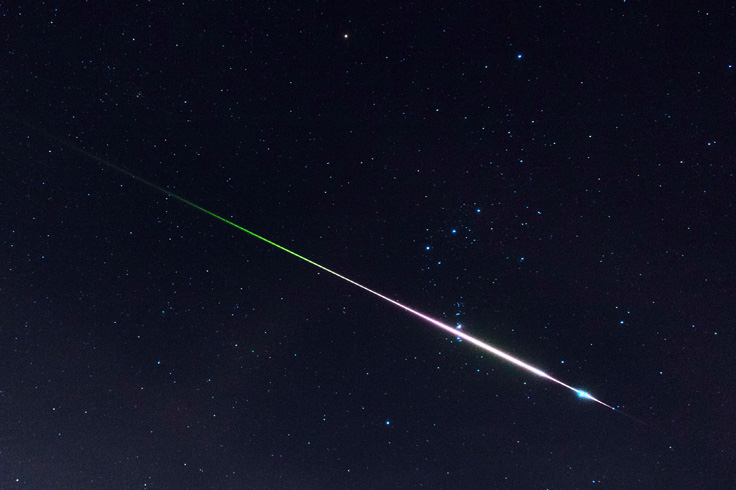
Kristi Deeley
Every day, Earth is bombarded by roughly 25 million bits of interplanetary debris, totaling more than 100 tons of dust and sand-sized particles. These fragments of space rock strike Earth’s upper atmosphere at speeds of 20 to 45 miles (30 to 70 km) per second, creating momentary streaks of light called meteors or “shooting stars.” And although some meteors look bright enough that it seems you can almost touch them, actually they occur very high up, at altitudes of 50 to 75 miles (80 to 120 km).
Derived from the Greek word meteoros (meaning “high in the air”), they’re actually fairly common. If you look up into a dark, Moonless night sky from a location far from city lights, you’ll see brief streaks from sporadic meteors a few times every hour. They can occur at any time on any night in any part of the sky. And they range in brightness from tiny blips just at the limit of visibility to dramatically bright fireballs that outshine Venus and light up the nightscape around you. The rarest of these, called a bolide, shatters explosively into pieces during its rapid descent and can even create a loud boom.

J. Kelly Beatty
Because they’re arriving so fast, it doesn’t take a very large particle to make a dramatic flash. Typically they’re no bigger than big sand grains, and something the size of a pea can create a meteor that’s dramatically bright. Those high velocities give each particle a lot of kinetic energy, which converts to heat due to friction in the upper atmosphere.
Many people think a meteor occurs because the particle is “burning up.” But actually friction with air molecules along the path flash-heats the particle and its immediate surroundings to thousands of degrees. The air molecules cool down in just a split second, giving off light as they do so.
What is a Meteor Shower?
Sporadic meteors are caused by a random mix of particles shed by both comets and asteroids. However, sometimes Earth encounters a stream of gritty debris scattered along the orbit of a periodic comet, and then our planet gets peppered by a higher concentration of particles arriving in a short period of time — a meteor shower.
Of all the celestial sights visible during the year, meteor showers seem to captivate public interest more than most — and it’s easy to understand why. For one thing, meteor showers are fairly predictable, coming at roughly the same times each year. And, because you know when to look for them, it’s exciting to watch bits of space rock create sudden, white-hot streaks of light as they slam into Earth’s atmosphere.
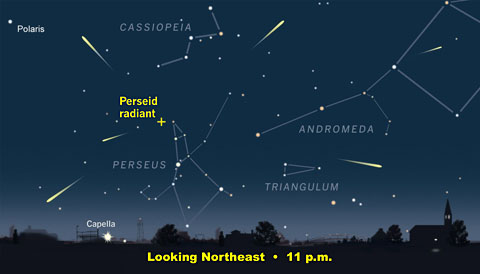
Sky & Telescope
You’ll notice the difference if you watch the sky for a half hour or more during one of these events: Not only do the number of meteors you’ll see go up, but also the meteors seem to fly away from a common point in the sky called the radiant. This is a trick of perspective, because all these particles are traveling in parallel — part of a vast but sparse “river of rubble” that’s spread all around the comet’s orbit.
To get a better sense of this, check out the interactive animation below, which is part of a set created by Ian Webster. It shows particles along the orbit of Comet 109P/Swift-Tuttle, which is the comet responsible for the Perseid meteor shower. (Have some fun with it: Click and drag the animation to get different perspectives):
A shower gets its name not from its parent object but from the constellation where its radiant lies. For example, August’s well-known Perseid shower has its radiant in Perseus, December’s Geminids appear to radiate from Gemini, and so forth. One notable exception to this rule is the Quadrantid shower, named for the now-defunct constellation Quadrans Muralis. Its radiant lies in what is now the constellation Boötes.
In any case, the higher a shower’s radiant, the more meteors it produces all over the sky. And meteor showers are usually at their best after midnight, during the hours before dawn. The graphic below explains why: That’s when you’re on the side of Earth facing forward along its orbit. Earth circles the Sun at about 20 miles (30 km) per second, so any bits of interplanetary debris slam into the predawn sky even faster, making each meteor brighter than it would have been if it had hit earlier in the evening, when they catch up to Earth’s trailing hemisphere.
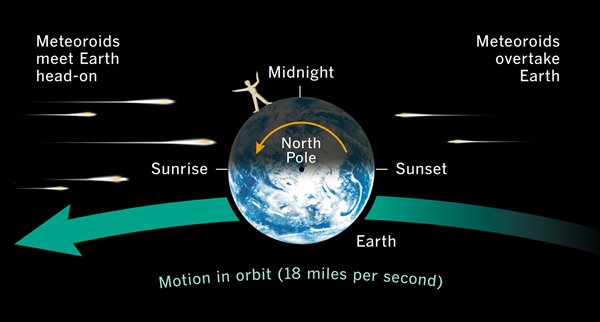
Sky & Telescope
Dynamicists have gotten rather good at predicting when a particular shower might display an extra burst of activity. Usually these are from concentrated streams of particles that might have been ejected by the parent comet decades or even centuries ago.
Also, some meteor showers deliver a relatively high proportion of large particles, which can create impressive displays of fireballs. The Perseid meteor shower creates the most fireballs, followed by the Geminids and Orionids. “The average peak magnitude for a Perseid observed by our cameras is –2.7; for the Geminids, it is –2,” explains NASA scientist Bill Cooke. “So on average, Geminid fireballs are about a magnitude fainter than those in the Perseids.”
The descriptions and table below highlight the year’s best and most dependable displays, but the International Astronomical Union now recognizes more than 100 well-defined meteor showers and hundreds of other candidates that haven’t been confirmed. Most of these are so weak that it takes a trained observer to spot them.
Must-See Meteor Showers in 2021
Here are highlights of the major meteor showers for 2021. For the best possible viewing experience, find a dark location free from light pollution, make yourself comfortable in a reclining chair, and wear plenty of warm clothing (as appropriate). And for more information on watching and studying meteors, see our article on meteor basics and the other articles in the Meteor section of this website.
The dates listed below correspond to the predawn hours closest to the predicted peak, though a shower is often active a few nights before and after the peak date. The peak rates listed are for ideal conditions: very dark skies, free of moonlight or light pollution, and with the radiant nearly overhead. Most likely you’ll see lower rates than those listed. Following the table are specific predictions for each shower’s prospects during 2021.
| Shower | Radiant and its direction | Morning of maximum | Peak rate (per hour) | Parent body |
| Quadrantid* | Draco (NE) | Jan. 4 | 60-120 | 2003 EH1 |
| Lyrid* | Lyra (E) | April 22 | 10-20 | Thatcher (1861 I) |
| Eta Aquariid | Aquarius (E) | May 5 | 20-60 | 1P/Halley |
| Delta Aquariid* | Aquarius (S) | July 29 | 20 | 96P/Machholz |
| Perseid | Perseus (NE) | Aug. 12 | 90 | 109P/Swift‑Tuttle |
| (unnamed) | Ara | Sep. 29, Oct. 7 | 50-100? | 15P/Finlay |
| Orionid* | Orion (SE) | Oct. 21 | 10-20 | 1P/Halley |
| Southern Taurid | Taurus (S) | Nov. 5 | 10-20 | 2P/Encke |
| Leonid* | Leo (E) | Nov. 17 | 10-20 | 55P/Tempel‑Tuttle |
| Geminid* | Gemini (S) | Dec. 14 | 100-120 | 3200 Phaethon |
| Ursid* | Ursa Minor (N) | Dec. 22 | 10 | 8P/Tuttle |
Bold type indicates the best predicted showers. (* Strong moonlight will interfere with these showers.)
January 4: The Quadrantids
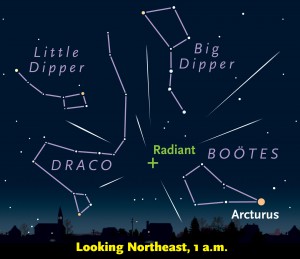
The “Quads” can deliver at least 1 meteor per minute under excellent sky conditions. In fact, the idealized zenithal hourly rate (ZHR), for someone with perfectly dark skies and the shower's radiant overhead, is a very high 110.
But in practice few observers ever see anything close to this many, because the shower’s maximum activity lasts only several hours and is easy to miss. Seeing 25 per hour is more typical. This year the peak occurs near 15h Universal Time (UT) on January 3rd — great for Asia but not great for North America. And the poor prospects are compounded by the presence of a Moon that’s just past full. You’ll have a couple hours of Moon-free darkness just after evening twilight on the evenings of January 2nd and 3rd.
The parent of this shower, an object designated 2003 EH1 after its discovery, loops around the Sun every 5½ years between the orbits of Earth and Jupiter. Meteor specialist Peter Jenniskens first realized that this body is responsible for the Quadrantid meteors. It’s not an active comet — more likely it’s an “extinct comet” that no longer has any ice. Curiously, although 2003 EH1 has had a permanent number (196256) for many years, it’s never been named by the discoverers. So suggest something in the comments section below!
April 22: The Lyrids
More than 3½ months pass until the next major meteor shower. April’s Lyrids put on a respectable show up to 3 days before and after its maximum, when you might glimpse one meteor every 5 minutes. The peak on April 22nd (near 12h UT) favors the western parts of the Americas, but there’ll be lots of interference from a waxing gibbous Moon. Your best bet is to be up and outside in the hour before dawn twilight begins, after the Moon has set and with the radiant near the Hercules-Lyra border high in the sky.
May 6: The Eta Aquariids
This annual shower originates from none other than Halley’s Comet, and these meteors come in fast: 41 miles (66 km) per second! This blazing speed often creates trains — something like incandescent smoke trails — that linger for several seconds after the meteors themselves come and gone. It’s a relatively strong performer for those in the Southern Hemisphere, delivering one meteor every couple of minutes under ideal conditions.
However, the shower’s radiant (in the Water Jar asterism of Aquarius) never gets very high above the horizon for observers in the Northern Hemisphere, and you’ll need to be out after midnight for the best views. If you go out to watch this year’s display, you’ll get bonus views of Jupiter, Saturn, and a waning crescent Moon in the general vicinity of the shower’s radiant.
July 29: The Delta Aquariids
This long-lasting shower, more formally called the Southern Delta Aquariids, has a radiant below the celestial equator and thus, like the Eta Aquariids, is best seen from the Southern Hemisphere. However, northerners can view its radiant well above the southern horizon for a couple of hours before and a few hours after midnight. The SDA shower has a reputation for delivering a steady stream of relatively faint meteors over several days, with counts as high as 20 per hour visible from the darkest locations. This year, the peak actually occurs on the evening of July 28th for North America, but after midnight on the 29th you’ll have competition from a waning gibbous Moon.
August 12: The Perseids
Even casual skywatchers know about the Perseid meteor shower, because it can deliver at least one meteor per minute under pleasant summer skies. But the shower’s peak performance is relatively brief, so timing is important. For North Americans, the shower’s 2021 maximum should come on the afternoon of August 12th.
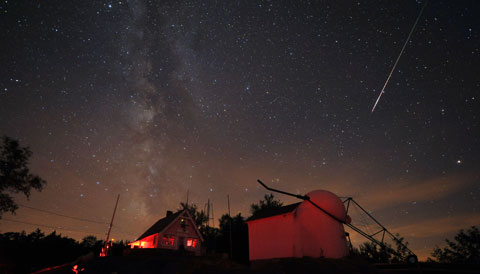
Dennis di Cicco
For North Americans, this shower can be enjoyed best that evening, as soon as its radiant (near the Double Cluster in Perseus) clears the northeastern horizon, by roughly 8 p.m. This is also when you’ll most likely see bright fireballs that skim Earth’s atmosphere and create long, dramatic streaks in the sky. At that time the Moon will be a waxing but still-thin crescent, so it will offer little interference.
These meteors are bits of debris shed by Comet 109P/Swift-Tuttle, which orbits the Sun every 130 years. Careful observers first realized that the Perseids are an annual event in the 1830s.
September 29th and October 7th
According to the International Meteor Society, some dynamicists are predicting that observers in the Southern Hemisphere will be treated to strong displays of up to 100 meteors per hour in late September and again in early October. These events are not from a named shower, though they will appear to radiate from the far-southern constellation of Ara, the Altar. There’ll be only minor interference from moonlight, which is important because the particles will arrive at slow speeds and will likely create relatively faint meteors.
The particles originate from Comet 15P/Finlay, which had an outburst in late 2014 when it last came closest to the Sun in its 6½-year-long orbit. The predicted timing — roughly 3h UT on September 29th and 1h UT on October 7th — will favor South America. But they’ll be invisible from North America, Europe, and most of Asia.
October 21: The Orionids
Here’s another modest shower due to Halley’s Comet. This year the timing of its peak, around 12h UT on October 21st, suggests that the evening of the 22nd is best suited for observers in North America and Europe. You can start watching around 9 p.m., after the shower’s radiant (located above Orion’s bright reddish star Betelgeuse) clears the horizon. But bright skyglow from a full Moon will be a big problem.
November 5: The Southern Taurids
Lasting from mid-September to mid-November, this broad, weak display typically produces at most a dozen meteors per hour at its peak. But defining that peak can be tricky: The International Meteor Organization predicts October 10th, while Canadian meteor researchers Margaret Campbell-Brown and Peter Brown state it’ll be November 5th. Part of the confusion arises because the nearby but distinct Northern Taurid shower also peaks in early November. (The northern component comprises bits of debris shed by Comet 2P/Encke, whereas the southern one is from “asteroid” 2004 TG10, which itself might be a fragment of Encke.)
In any case, let’s go with November 5th, when the Moon will be new. By then the radiants of these paired showers will both be in western Taurus, along its border with Cetus. You might notice that Taurid meteors don’t zip across the sky very quickly — they strike the atmosphere at a relatively slow 19 miles (30 km) per second.
November 17: The Leonids
The Leonid shower’s parent comet, 55P/Tempel-Tuttle, tends to create narrow concentrated streams of debris that produced prodigious displays in the late 1990s, when it last swung close to the Sun. Since then the shower’s activity has varied from year to year, usually offering little more than a trickle of shooting stars radiating from Leo’s Sickle. This year’s peak comes late on November 17th, which unfortunately features a not-quite-full Moon.
December 14: The Geminids
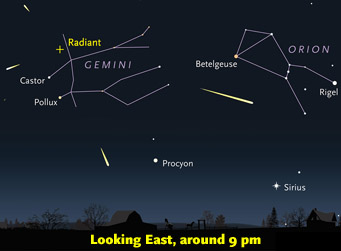
Sky & Telescope diagram
This end-of-the-calendar shower is usually the year’s best and most reliable, with upward of 100 meteors per hour radiating from a spot near the bright star Castor. The Geminid radiant is well up in the sky by 9 p.m. as seen from at mid-northern latitudes.
Timing will be important, because this shower’s peak is strong but brief (near 7h UT on the 14th). This is great timing for North Americans, especially in the western half (11 p.m. PST on the evening of the 13th). Unfortunately, unlike last year’s peak in Moon-free skies, the 2021 Geminids arrive with the Moon just about full.
Geminid meteors come from 3200 Phaethon, an asteroid discovered in 1983 that circles the Sun every 3.3 years. In fact, recent observations suggest that Phaethon might be a “rock comet” that sheds particles when its surface heats up to roughly 1,300°F (700°C) at each perihelion.
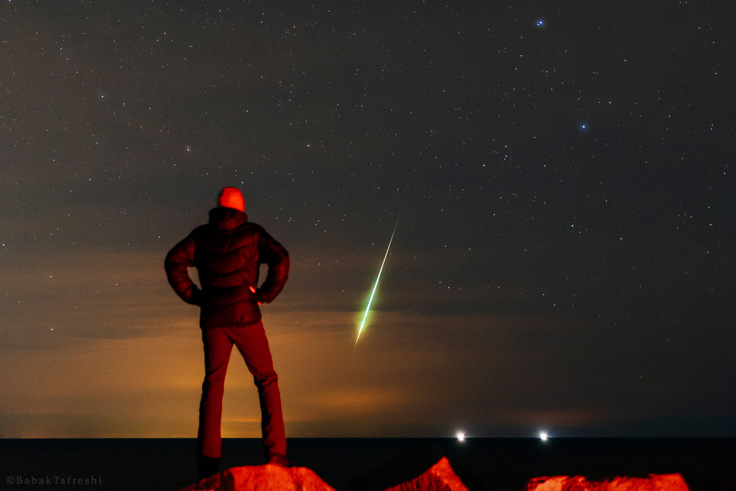
Babak Tafreshi
December 22: The Ursids
Although the Ursid shower delivers only a modest 10 meteors per hour under even the best conditions, it has the advantage of having a radiant near the bowl of the Little Dipper — so it’s in view all night from northern latitudes. Peak activity, which lasts just a few hours, is predicted for around 16h UT — poorly timed for North America and Europe. And the Moon is just one day past full.
The editors of Sky & Telescope have assembled a complete guide to meteor observing, with resources for beginners and experienced amateurs alike. Our FREE Shooting Stars eBook covers the history, art, and science of meteor showers; just enter your email address below to access this download.
 0
0
Comments
You must be logged in to post a comment.